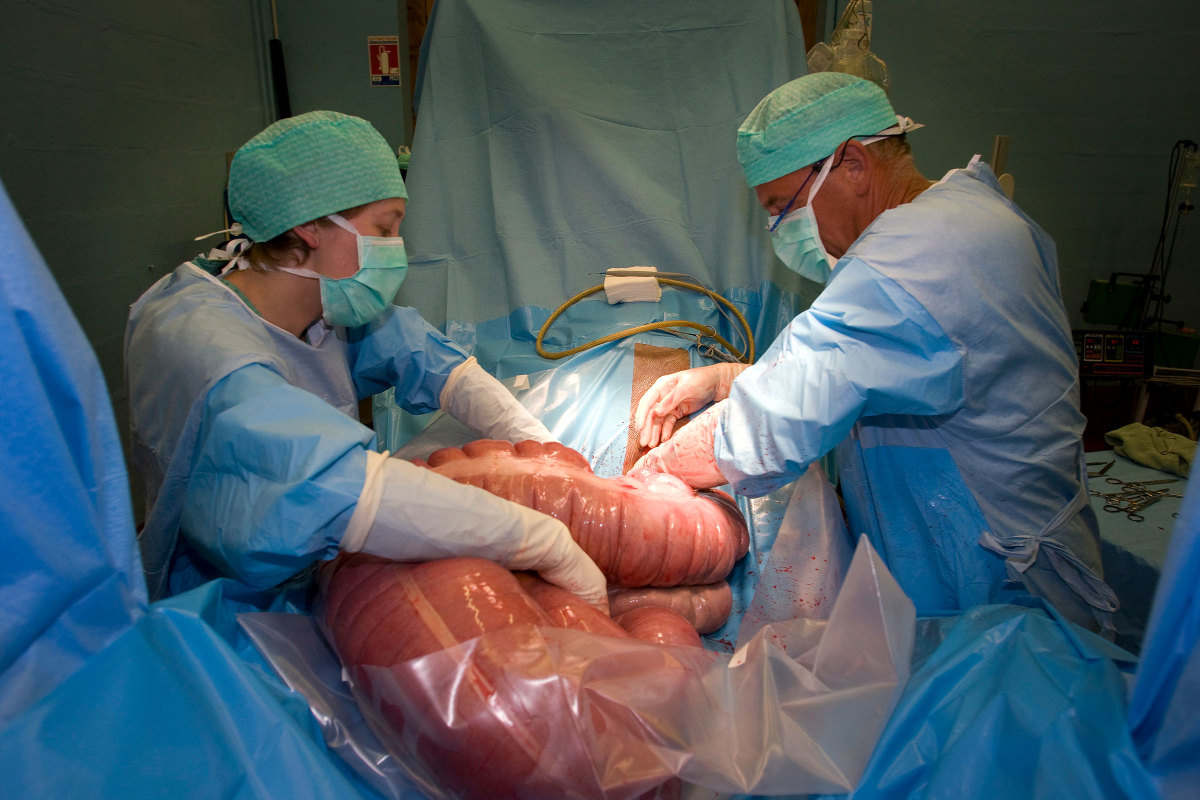
Materials selected for closure of the abdominal midline following equine surgery are important to avoid surgical site infection, dehiscence, or herniation. A study compared the use of n-butyl cyanoacrylate (NBC) to stainless steel skin staples (SS) in horses surviving at least 15 days following colic surgery [Martinez-Lopez, J.; Brown, J.A.; Werre, S.R. Incisional complications after skin closure with n-butyl cyanoacrylate or stainless-steel skin staples in horses undergoing colic surgery. Veterinary Surgery 2021; 50;186-195; DOI: 10.1111/vsu.13534].
Good apposition of the skin at closure is important to minimize contamination of the incision site, especially during surgical recovery. Some surgeons are concerned that stainless steel staples are not able to adequately bridge the skin gap for full apposition. In humans and dogs, cyanoacrylates have been shown to have similar or lower surgical site infection rates. Cyanoacrylate has the ability to bridge the incision and hold skin edges together as it polymerizes on contact with blood to form a solid film. By 5-10 days after application, cyanoacrylate sloughs away, yet while present, it provides some anti-bacterial effects.
The study evaluated from medical records at the Marion duPont Scott Equine Medical Center from 2014–2018. It included 218 horses that underwent colic surgery. All horses had subcutaneous closure. Skin closure was done with SS in 113 (51.8%) while 105 (48.2%) were closed with NBC, which is FDA approved for veterinary use. It is noteworthy that horses receiving SS for closure had longer anesthetic times of about 20 minutes.
While in hospital, the most common complication was surgical site infection (SSI) in 11 of 14 (78.6%) horses developing an incisional complication. An increased packed cell volume on admission was associated with in-hospital complications.
Of the 218 cases, 166 were available for follow-up for up to 28.5 months, and including five in-hospital complications, 30 of 171 horses (17.5%) developed incisional issues:
- Before discharge, five (6.4%) of the horses developed complications.
- 16 of 166 (9.6%) developed post-discharge incisional complications.
- Of these 16, 9/86 (10.5%) were closed with SS and 7/80 (8.8%) were closed with NBC.
- Post-discharge complications included: Hernia (5), drainage (6), drainage and subsequent hernia (2), erythema (1), firm swelling on incisional scar (1), prolonged edema and sheath swelling (1).
- Horses with an in-hospital complication had a 12.1-fold greater risk of post-discharge complications.
- Surgical site infection occurred in 20/171 (11.7%)
- Hernia formed in 10/171 (5.8%).
Of the 166 horses followed between 9 months and 4.6 years, 78.9% returned to the same or higher level of performance and 3.6% performed at a lower level. Those not able to return to their intended use numbered 24 (14.5%). Of those, 19 died or were retired for non-colic reasons while five were retired due to owner decision.
In summary, the authors stated: “There was no statistical difference in incisional complications between SS closure 19.1% (17/89) and NBC closure (15.9% (13/82), and no difference in surgical site infection with SS 12.4% (11/89) compared to NBC 11% (9/82), and no difference in hernia development with SS 6.7% (6/89) compared to NBC 4.9% (4/82).”
The study concluded: “The prevalence of incisional complications with NBC was not different from SS. Benefits of wound closure with cyanoacrylates include fast application, cost equivalence to SS, and no procedure-related pain associated with staple removal.”








